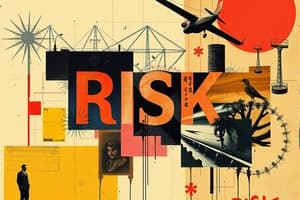Podcast
Questions and Answers
What is the primary purpose of risk analysis in project management?
What is the primary purpose of risk analysis in project management?
- To evaluate project timelines and deadlines
- To analyze the likelihood and consequences of identified risks (correct)
- To identify all stakeholders involved in the project
- To create a budget for the project
Which of the following best describes the likelihood scale used in risk evaluation?
Which of the following best describes the likelihood scale used in risk evaluation?
- It assesses how expensive a risk might be
- It estimates the chance of a risk event occurring (correct)
- It identifies all potential risks in a project
- It determines the severity of loss if a risk occurs
What should be done if a risk does not fit into the low or acceptable category?
What should be done if a risk does not fit into the low or acceptable category?
- It should be treated using one or more treatment options (correct)
- It should be avoided entirely at all costs
- It should be documented and revisited after project completion
- It should be ignored and monitored over time
How does the risk priority scale assist project management?
How does the risk priority scale assist project management?
What does the loss or damage impact scale evaluate during risk evaluation?
What does the loss or damage impact scale evaluate during risk evaluation?
What does estimating activity resources involve?
What does estimating activity resources involve?
What is a key benefit of effective project time management?
What is a key benefit of effective project time management?
Which of the following is NOT a time management failure?
Which of the following is NOT a time management failure?
What should be done before starting the workday according to time management practices?
What should be done before starting the workday according to time management practices?
What action can help ensure that intended results are achieved during calls and tasks?
What action can help ensure that intended results are achieved during calls and tasks?
Why is it recommended to schedule time for interruptions?
Why is it recommended to schedule time for interruptions?
Which strategy is suggested to help manage distractions while working?
Which strategy is suggested to help manage distractions while working?
What is one way to improve the opportunities for achieving important life and career goals?
What is one way to improve the opportunities for achieving important life and career goals?
Which area of project management focuses on coordinating various processes and activities?
Which area of project management focuses on coordinating various processes and activities?
What does Project Scope Management primarily define?
What does Project Scope Management primarily define?
Which area of project management deals with organizing and planning time across activities?
Which area of project management deals with organizing and planning time across activities?
How many key areas of project management are defined in the Project Management Body of Knowledge (PMBOK)?
How many key areas of project management are defined in the Project Management Body of Knowledge (PMBOK)?
Which area of project management is concerned with managing project stakeholders?
Which area of project management is concerned with managing project stakeholders?
What is the purpose of grouping processes into Project Management Knowledge Areas?
What is the purpose of grouping processes into Project Management Knowledge Areas?
Which area of project management involves planning resource allocation and quality control?
Which area of project management involves planning resource allocation and quality control?
Which of the following is NOT one of the ten key areas of project management?
Which of the following is NOT one of the ten key areas of project management?
What is the primary purpose of Cost-Benefit Analysis in project procurement management?
What is the primary purpose of Cost-Benefit Analysis in project procurement management?
Which procurement management process involves documenting decisions on how procurements will be managed?
Which procurement management process involves documenting decisions on how procurements will be managed?
What does Risk Analysis help project teams to identify?
What does Risk Analysis help project teams to identify?
Which stakeholder is you least likely to engage during a project?
Which stakeholder is you least likely to engage during a project?
What is the key role of Project Stakeholders in a project?
What is the key role of Project Stakeholders in a project?
In which phase are seller responses obtained and contracts awarded?
In which phase are seller responses obtained and contracts awarded?
Which analysis method typically offers a more detailed analysis than Cost-Benefit Analysis?
Which analysis method typically offers a more detailed analysis than Cost-Benefit Analysis?
What is the function of the Administer Procurements process?
What is the function of the Administer Procurements process?
What is the primary purpose of scheduling project activities?
What is the primary purpose of scheduling project activities?
Which of the following is NOT a responsibility of a software project manager?
Which of the following is NOT a responsibility of a software project manager?
In project scheduling, what does the term 'Critical Path' refer to?
In project scheduling, what does the term 'Critical Path' refer to?
What is a Gantt chart primarily used for in project management?
What is a Gantt chart primarily used for in project management?
What is the purpose of a Work Breakdown Structure (WBS)?
What is the purpose of a Work Breakdown Structure (WBS)?
Which task must occur before another in a project sequence?
Which task must occur before another in a project sequence?
What is the first step in project scheduling?
What is the first step in project scheduling?
What do subsequent or successor activities require?
What do subsequent or successor activities require?
What does the Forward Crossing estimate provide for each activity?
What does the Forward Crossing estimate provide for each activity?
What is required to find the Earliest Finish time for an activity?
What is required to find the Earliest Finish time for an activity?
In a project network, what is meant by the Critical Path?
In a project network, what is meant by the Critical Path?
How is the Earliest Start time determined for an activity leaving a node?
How is the Earliest Start time determined for an activity leaving a node?
Which of the following accurately describes an activity's duration?
Which of the following accurately describes an activity's duration?
What is indicated when several activities can be conducted simultaneously in a project?
What is indicated when several activities can be conducted simultaneously in a project?
What does the Backward Crossing estimation provide for an activity?
What does the Backward Crossing estimation provide for an activity?
If activity A has an Earliest Start of 0 weeks and a duration of 5 weeks, what is its Earliest Finish time?
If activity A has an Earliest Start of 0 weeks and a duration of 5 weeks, what is its Earliest Finish time?
Flashcards
Estimate Activity Resources
Estimate Activity Resources
Estimating the materials, labor, machines, or supplies needed for a project activity.
Estimate Activity Durations
Estimate Activity Durations
Estimating how long an activity will take, considering the resources available.
Develop Schedule
Develop Schedule
Creating a plan for project completion, incorporating activity sequences, durations, resource needs, and constraints.
Control Schedule
Control Schedule
Signup and view all the flashcards
Time Management Benefits
Time Management Benefits
Signup and view all the flashcards
Time Management Failure
Time Management Failure
Signup and view all the flashcards
Schedule Appointments with Yourself
Schedule Appointments with Yourself
Signup and view all the flashcards
Plan for Interruptions
Plan for Interruptions
Signup and view all the flashcards
Project Integration Management
Project Integration Management
Signup and view all the flashcards
Project Scope Management
Project Scope Management
Signup and view all the flashcards
Project Time Management
Project Time Management
Signup and view all the flashcards
Project Cost Management
Project Cost Management
Signup and view all the flashcards
Project Communications Management
Project Communications Management
Signup and view all the flashcards
Project Quality Management
Project Quality Management
Signup and view all the flashcards
Project Human Resource Management
Project Human Resource Management
Signup and view all the flashcards
Project Risk Management
Project Risk Management
Signup and view all the flashcards
Risk Analysis
Risk Analysis
Signup and view all the flashcards
Risk Evaluation
Risk Evaluation
Signup and view all the flashcards
Likelihood Scale
Likelihood Scale
Signup and view all the flashcards
Loss/Damage Impact Scale (Consequences)
Loss/Damage Impact Scale (Consequences)
Signup and view all the flashcards
Risk Priority Scale
Risk Priority Scale
Signup and view all the flashcards
Cost-Benefit Analysis
Cost-Benefit Analysis
Signup and view all the flashcards
Cost-Utility Analysis
Cost-Utility Analysis
Signup and view all the flashcards
Risk Analysis in Procurement
Risk Analysis in Procurement
Signup and view all the flashcards
Plan Procurements Process
Plan Procurements Process
Signup and view all the flashcards
Conduct Procurements Process
Conduct Procurements Process
Signup and view all the flashcards
Administer Procurements Process
Administer Procurements Process
Signup and view all the flashcards
Close Procurements Process
Close Procurements Process
Signup and view all the flashcards
Stakeholder Management in Projects
Stakeholder Management in Projects
Signup and view all the flashcards
Forward Crossing
Forward Crossing
Signup and view all the flashcards
Backward Crossing
Backward Crossing
Signup and view all the flashcards
Critical Path
Critical Path
Signup and view all the flashcards
Earliest Start (ES)
Earliest Start (ES)
Signup and view all the flashcards
Earliest Finish (EF)
Earliest Finish (EF)
Signup and view all the flashcards
Latest Start (LS)
Latest Start (LS)
Signup and view all the flashcards
Latest Finish (LF)
Latest Finish (LF)
Signup and view all the flashcards
Activity Float
Activity Float
Signup and view all the flashcards
Project Scheduling
Project Scheduling
Signup and view all the flashcards
Gantt Chart
Gantt Chart
Signup and view all the flashcards
Work Breakdown Structure (WBS)
Work Breakdown Structure (WBS)
Signup and view all the flashcards
Activity Dependency
Activity Dependency
Signup and view all the flashcards
PERT (Project Evaluation & Review Technique)
PERT (Project Evaluation & Review Technique)
Signup and view all the flashcards
Project Crashing
Project Crashing
Signup and view all the flashcards
Network Diagram
Network Diagram
Signup and view all the flashcards
Study Notes
Introduction to Project Management
- Project Management is a systematic approach to achieve specific goals within the constraints of time, scope, and budget.
- A project is a temporary endeavor undertaken to produce a unique product, service, or result.
- Projects are different from operations as they are temporary, unique, and have a defined beginning and end.
Project Management Knowledge Areas
- Project Management is divided into ten knowledge areas.
- These areas are grouped into categories to help organize related project processes, tools, and techniques.
- Key knowledge areas:
- Project Integration Management,
- Project Scope Management,
- Project Time Management,
- Project Cost Management,
- Project Communications Management,
- Project Quality Management,
- Project Human Resource Management,
- Project Risk Management,
- Project Procurement Management,
- Project Stakeholder Management.
Project Scheduling (Planning)
- Project scheduling is a significant part of project preparation. It involves determining which activities (tasks) will be completed and when.
- Key components of project scheduling:
- Identifying activities,
- Identifying dependencies,
- Estimating resources,
- Assigning people to conduct activities,
- Creating activity network and bar charts.
- Tools used to schedule projects:
- Gantt charts,
- Work Breakdown Structure (WBS),
- Network diagrams that show task dependencies.
Project Selection
- The approaches to project selection often involve checklists, scoring models, and financial models.
- Some financial models in project selection include:
- Payback analysis,
- Net present value (NPV),
- Return on investment (ROI).
Project Evaluation and Controlling
- Project controlling includes monitoring project performance, milestone analysis, earned value management, human factors in project evaluation, and factors for successful project implementation.
Project Organization & Roles
- Stakeholders are individuals, groups, or organizations with an interest in a project.
- Project management involves various roles, including project managers, project team members, senior management, sponsors, and stakeholders like suppliers, customers, vendors, and end users.
Project Management Skills
- Project managers need various skills, including hard skills and soft skills.
- Hard skills include planning, problem-solving, budgeting, scheduling, and risk management.
- Soft skills involve communication, leadership, conflict resolution, negotiation, empathy, and adaptability.
Why Projects Fail?
- Common reasons why projects fail include:
- Failing to align the project with organizational goals,
- Poor scope management (scope creep),
- Poor communication,
- Unrealistic expectations,
- Lack of executive sponsorship,
- Insufficient project management skills,
- Inability to resolve individual or personality conflicts,
- Political factors.
Why Projects Succeed
- Successful projects often share these common characteristics:
- A well-defined project charter,
- Open and effective communication,
- Strong decision-making and managerial skills,
- Executive-level sponsorship,
- Effective team with a shared goal orientation.
Defining Projects Succeed
- Successful projects can be defined by factors such as:
- Completion within the allocated time frame and budget.
- Meeting or exceeding specified performance or specification requirements.
- Obtaining customer/user validation and agreement on scope changes.
- Not disrupting the workflow of the organization
- Without changing the corporate culture
The Potential Benefits from Project Management
- Identifying all involved tasks and functional responsibilities.
- Minimizing the need for continuous reporting.
- Identifying time limits for scheduling
- Identifying a methodology for trade-off analysis.
- Measuring accomplishments against plans.
- Early identification of problems.
- Improved estimating of capabilities for future use.
- Recognizing when objectives cannot be met or exceeded.
Benefits of Project Management
- Centralized control over work and goals
- Increase workflow efficiency
- Enhanced organizational effectiveness
- Improved communication and alignment.
Studying That Suits You
Use AI to generate personalized quizzes and flashcards to suit your learning preferences.





